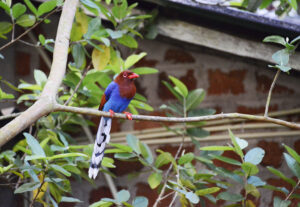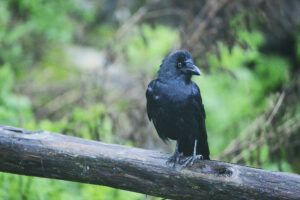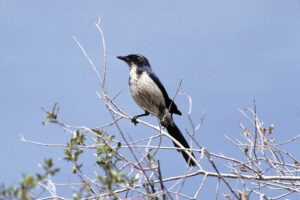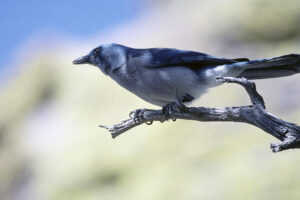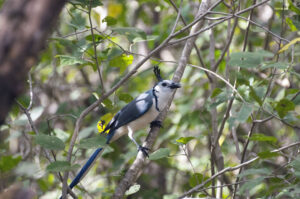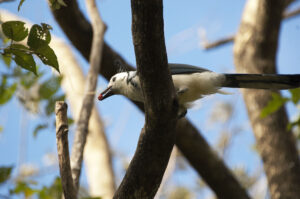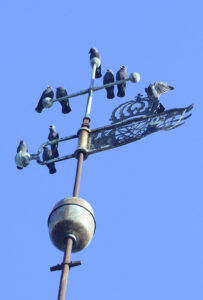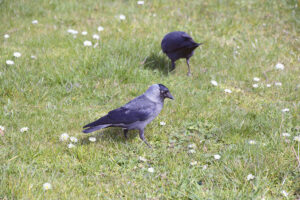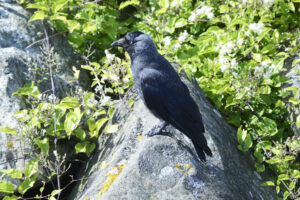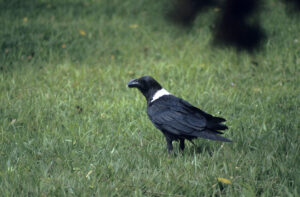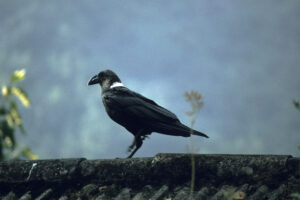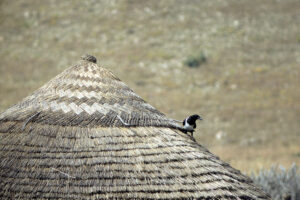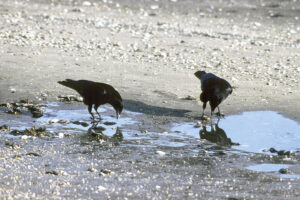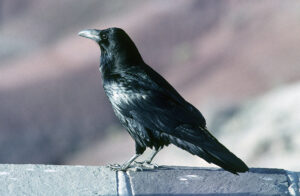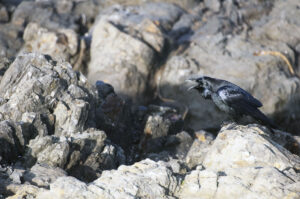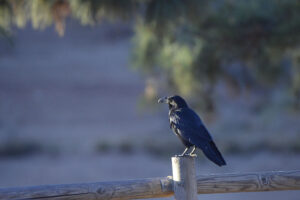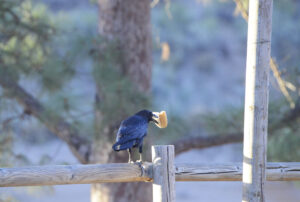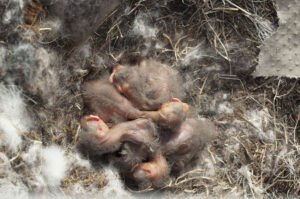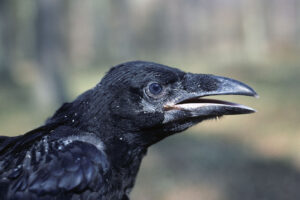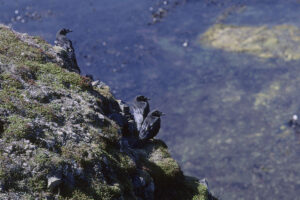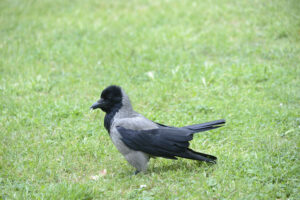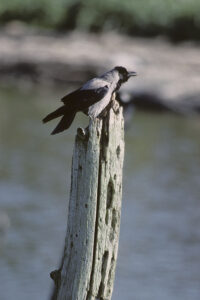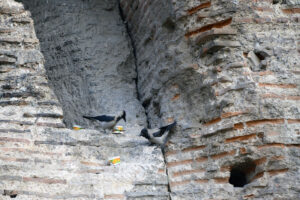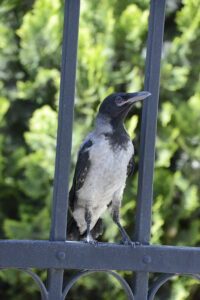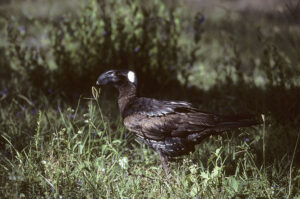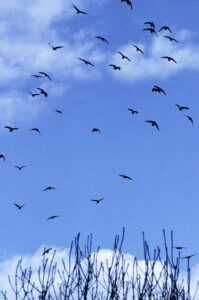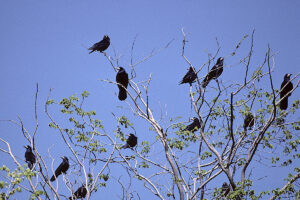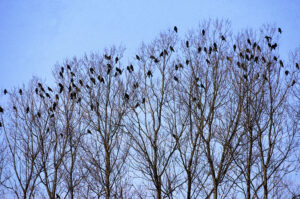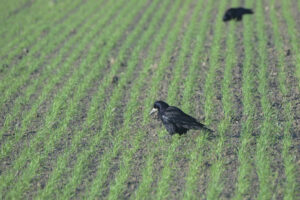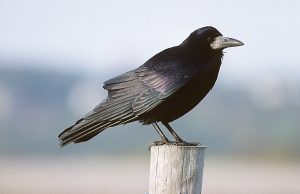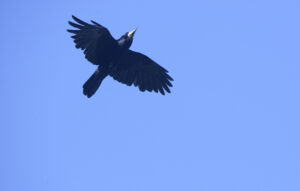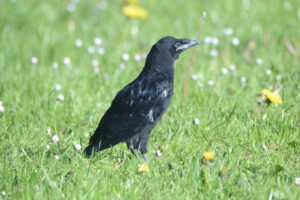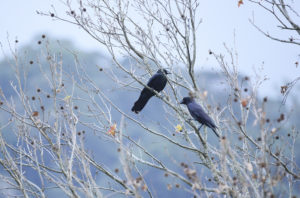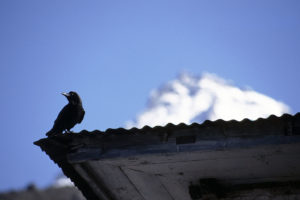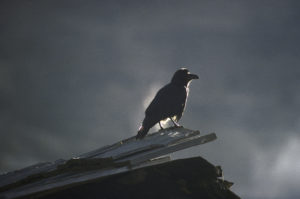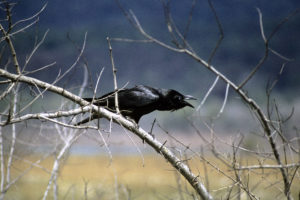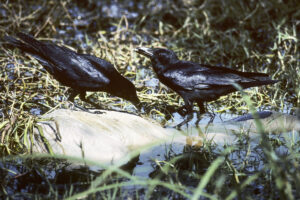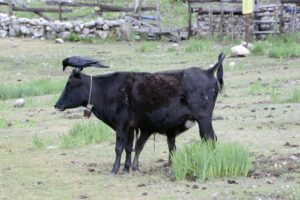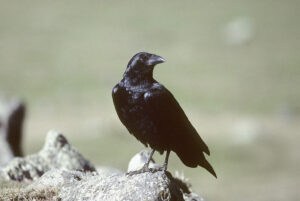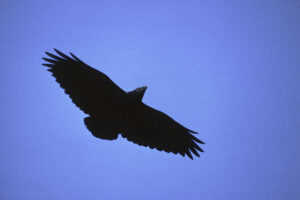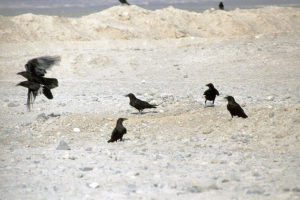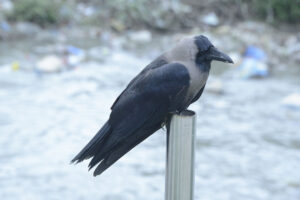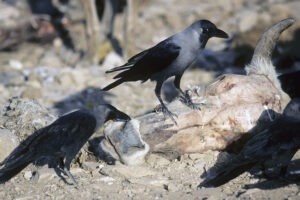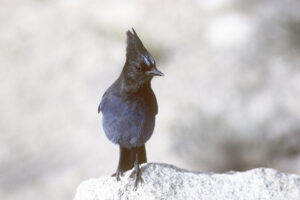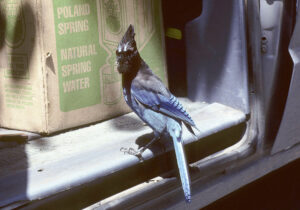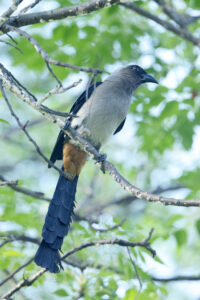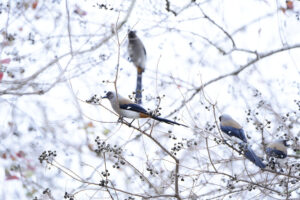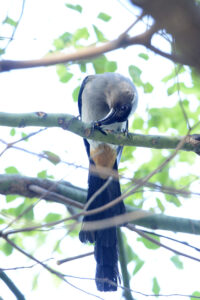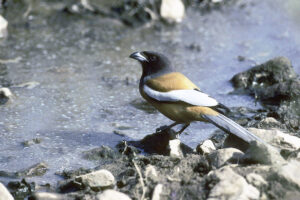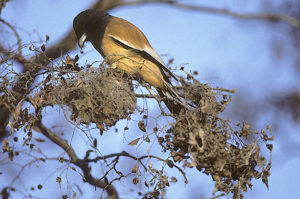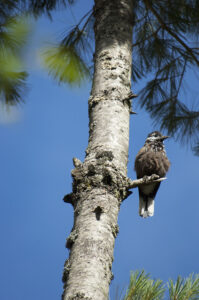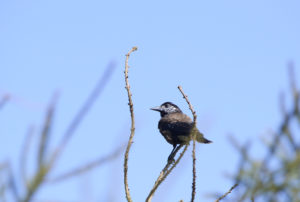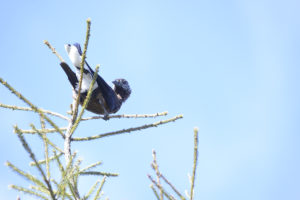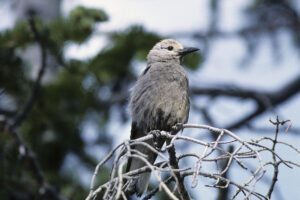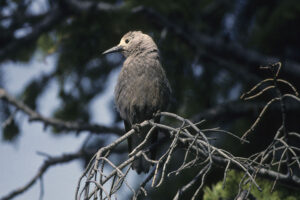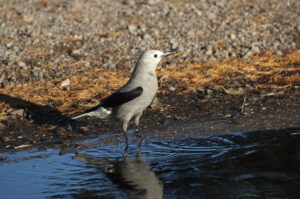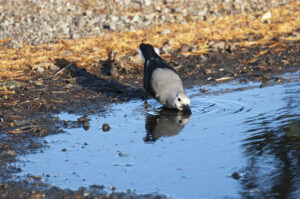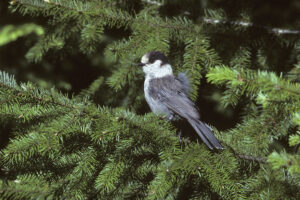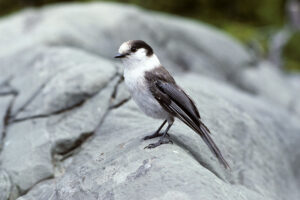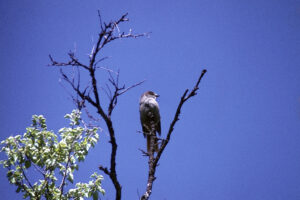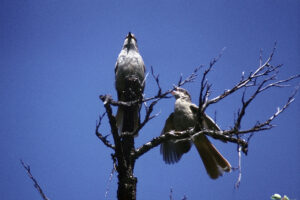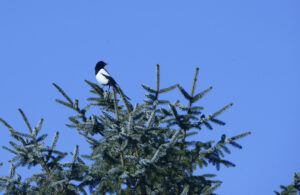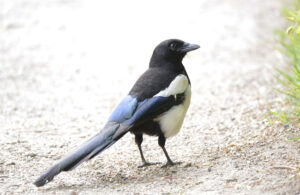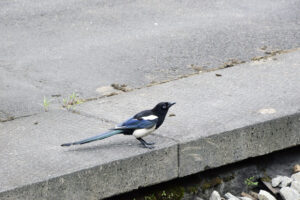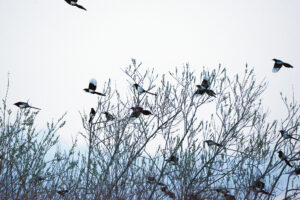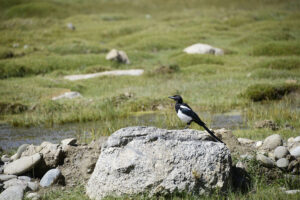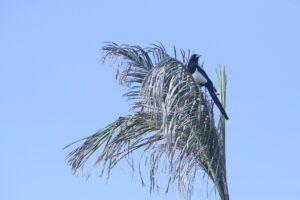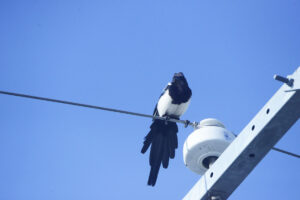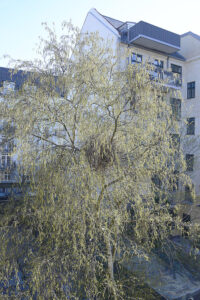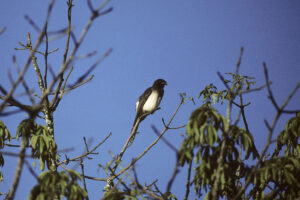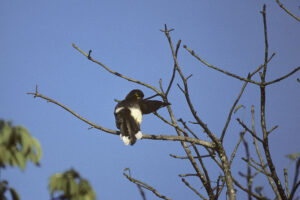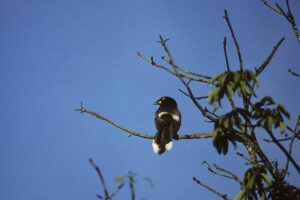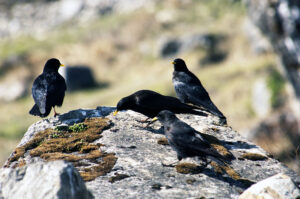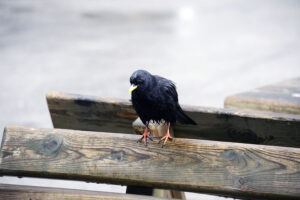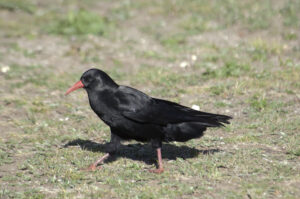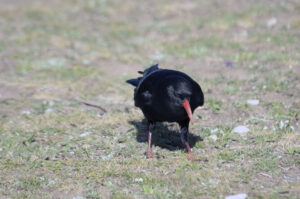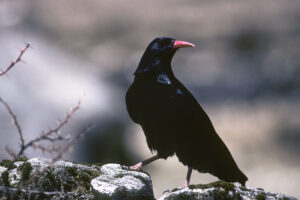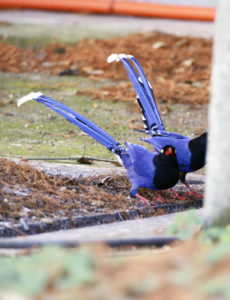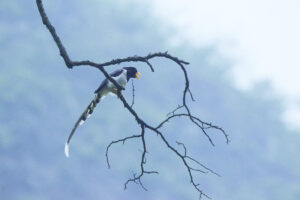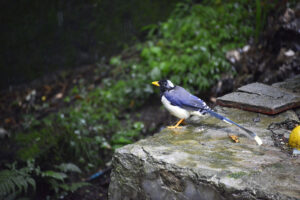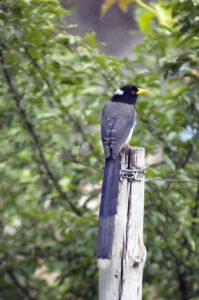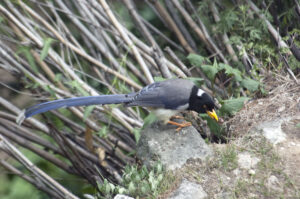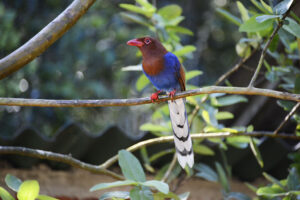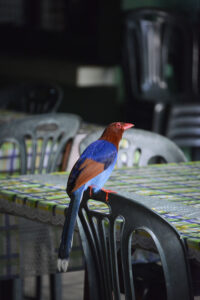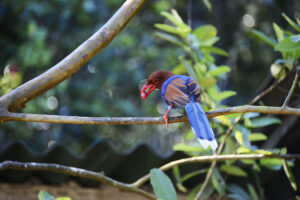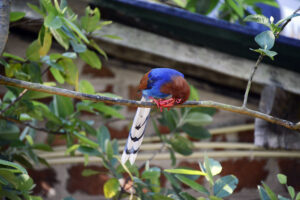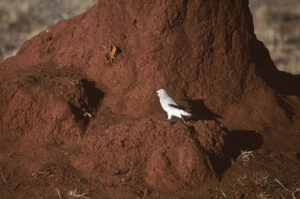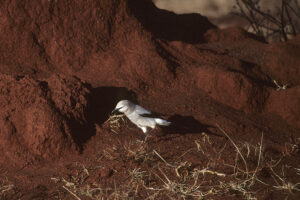Corvids
Perched on a sign in Death Valley National Park, California, this raven (Corvus corax) is gasping in the heat. (Photo copyright © by Kaj Halberg)
White-throated magpie-jay (Calocitta formosa), Santa Rosa National Park, Guanacaste, Costa Rica. (Photo copyright © by Kaj Halberg)
Sri Lanka blue magpie (Urocissa ornata), Sinharaja Forest Reserve, western Sri Lanka. (Photo copyright © by Kaj Halberg)
Alpine chough (Pyrrhocorax graculus), encountered at the hamlet of Tughla, Khumbu, eastern Nepal. (Photo copyright © by Kaj Halberg)
Large-billed crow (Corvus macrorhynchos), Gopte, Langtang National Park, Nepal. (Photo copyright © by Kaj Halberg)
On cloud-trails I go,
Alone, with the chatting porters.
There is a crow.
Haiku, written by German-American biologist and environmentalist George B. Schaller (b. 1933), quoted by American author Peter Matthiessen (1927-2014) in his book The Snow Leopard (1978). The crow in question is large-billed crow (Corvus macrorhynchos), see picture above.
“When the sun begins to illuminate the snow-covered mountain tops, I get up and start boiling tea. My only kitchen implement is a large iron mug, on which the enamel is hidden beneath a thick layer of soot. I fill it up at a spring which comes purling down over the rocks in a nearby gorge, and which I reach via a narrow ledge. On the way back I have to be very careful not to spill the raw material for the elixir I’m about to brew. Naturally, the tea has to be so strong that it resembles coffee, and it gets a delicious taste, partly by drawing for half an hour, partly from the smoke from the fire. With the tea, I eat my last achievement in the art of cooking – the local barley flour, stirred into cold water. My plate is a flat piece of slate that I have borrowed from some insects, which were using it as a roof. They’ll get it back when I have finished using it. It is an advantage that I don’t have to do any dishing, because in the afternoon a couple of black crows with shiny bills arrive to peck away the last dried remains. In the beginning they were on their guard, looking at me askance, but now they are so bold that I have to be careful what else they might steal.”
Extract from the book Bøj dig for Shiva (‘Bow to Shiva’, 1965, in Danish), by Danish author Sten Kjærulff Nielsen (born 1938). The crow in question is large-billed crow (Corvus macrorhynchos), see picture above.
Crows, ravens, rooks, jackdaws, jays, magpies, treepies, choughs, nutcrackers, and many others constitute the family Corvidae, which contains 24 genera with more than 120 species. Members of this family are found in most parts of the globe.
Aphelocoma Scrub jays
Previously, this genus contained only 3 species, but a number of splits have increased the number to 7. They are medium-sized birds with a mainly blue and grey plumage, living in western United States, Mexico, and western Central America, eastwards to western Nicaragua, with an isolated species in Florida.
The generic name is derived from Ancient Greek apheles (‘naïve’, but in this connection translated as ‘simple’) and kome (‘well-tended hair’), given in allusion to the lack of stripes or bands on these birds, compared to other jays.
Aphelocoma californica California scrub jay
This species is native to a broad coastal belt in western North America, from extreme southern British Columbia southwards through Washington, Oregon, California, and extreme western Nevada, to the southern tip of Baja California. It lives in low scrub, piñon-juniper forests, oak woods, and also in suburban gardens, where it often becomes confiding, feeding at bird feeders.
This bird was once lumped with 3 other species, collectively simply called the scrub jay. Then two populations were split to form separate species, the Florida scrub jay (A. coerulescens), which lives in Florida, and the island scrub jay (A. insularis), which is confined to Santa Cruz island off the Californian coast. The remaining populations were now called western scrub jay. Later, the inland populations were split to form a new species, Woodhouse’s scrub jay (A. woodhouseii), whereas the coastal populations were named California scrub jay.
California scrub jay, Joshua Tree National Park, California. (Photos copyright © by Kaj Halberg)
Aphelocoma wollweberi Mexican jay
This bird, with blue upperparts and grey underparts, was formerly known as grey-breasted jay (A. ultramarina), but in 2011 it was split into two species, the northern populations now called Mexican jay, with the Latin name A. wollweberi, whereas the central Mexican population, now called Transvolcanic jay, retained the name A. ultramarina.
The Mexican jay is distributed from eastern Arizona and western New Mexico southwards along the Sierra Madre Occidental, almost to Mexico City, and thence northwards along the Sierra Madre Oriental to the Chisos Mountains in southern Texas.
The specific name honours a German traveller, named Wollweber, who collected birds in Mexico in the 1840s for the Darmstadt Museum in Germany. Apart from that we know nothing about him, as the archives of the Darmstadt Museum were destroyed during World War II.
Mexican jay, Chiricahua National Monument, Arizona. (Photo copyright © by Kaj Halberg)
Calocitta Magpie-jays
A small genus of two species, found in Mexico, Guatemala, and Costa Rica. The generic name is derived from Ancient Greek kalos (‘beautiful’), and kitta, which originally was the name of the jay (Garrulus glandarius), but in this connection means ‘magpie’.
Calocitta formosa White-throated magpie-jay
A large and long-tailed species, with a total length of up to 56 cm, distributed in dry thorn forest and semi-humid woodland along the Pacific coast from Jalisco, Mexico to Guanacaste, Costa Rica. It usually lives below an elevation of 800 m, but may occasionally be encountered up to 1,250 m.
This noisy bird often travels about in flocks. The specific name is Portuguese, like the generic name meaning ‘beautiful’. It is indeed a very pretty bird, with a prominent curved black-and-white crest on the crown, blue wings and upper tail, and a pure white underside with a thin dark-blue line, running from the nape across the upper breast.
White-throated magpie-jays, Santa Rosa National Park, Guanacaste, Costa Rica. In the bottom picture, they are drinking from a sink in a campground. (Photos copyright © by Kaj Halberg)
Coloeus Jackdaws
Previously, jackdaws were placed in the genus Corvus (below), but, following genetic research, they have been moved to a separate genus, containing one or two species, depending on authority.
The generic name is a Latinized form of koloios, the Ancient Greek term for the jackdaw.
Coloeus monedula Eurasian jackdaw
This small corvid, which was previously named Corvus monedula, is ubiquitous in cities all over Europe. It is distributed from southern Finland and Scandinavia southwards to the Mediterranean, and thence eastwards to Central Asia. In eastern Siberia, Mongolia, and China, it is replaced by a near relative, the Daurian jackdaw (C. dauuricus), which may possibly be a race of the Eurasian jackdaw, as they often interbreed.
The specific name is derived from the Latin moneta (‘coin’), thus named by Swedish naturalist Carl Linnaeus (1707-1778), allegedly because this bird often picks up coins and other shining items.
Jackdaws, resting on the weather vane of Vor Frue Kirke (‘Church of Our Lady’), Nyborg, Denmark, initiated in 1389 during the reign of Queen Margrete I (1353-1412). (Photo copyright © by Kaj Halberg)
Jackdaws, feeding on a lawn, Nyborg. The plant with white flowers is common daisy (Bellis perennis). (Photo copyright © by Kaj Halberg)
Confiding jackdaw, Nyborg Harbour. The plant is traveller’s joy (Clematis vitalba). (Photo copyright © by Kaj Halberg)
Skeletons of jackdaws which, through a 144-year-long period (1829-1972), fell into a chimney, Selsø Castle, northern Zealand, Denmark. The castle was uninhabited during this period. (Photo copyright © by Kaj Halberg)
Corvus Ravens, crows, rooks
This genus with about 45 members occurs in virtually all temperate areas of the globe, with the exception of South America. The word raven generally applies to the largest species, although some smaller species are also named raven, including the fan-tailed raven (below). The words crow and rook apply to slightly smaller species. Members of this genus are among the most intelligent birds.
The generic name is the classical Latin name of the common raven (below).
Previously, jackdaws were also placed in this genus. Following genetic research, they have been moved to a separate genus, Coloeus (above).
Corvus albicollis White-necked raven
This species is black with a white patch is on the lower hind neck. It is native from eastern Zaire, Uganda, and Kenya southwards through south-eastern Africa to the Cape area. It is mainly found in montane areas and has readily adapted to living in villages and smaller towns.
The specific name is derived from the Latin albus (‘white’) and collum (‘neck’).
White-necked raven, Kigali, Rwanda. (Photo copyright © by Kaj Halberg)
White-necked raven, Ruwenzori National Park, eastern Zaire. (Photo copyright © by Kaj Halberg)
Corvus albus Pied crow
This widespread species occurs in the entire Africa south of the Sahara, with the exception of rainforests and deserts. It is also found in Madagascar, and on many islands around Africa, including the Comoros, Aldabra, and Fernando Po. It inhabits mainly open country, often encountered in villages and towns.
The specific name is Latin, meaning ‘white’.
Pied crow, sitting on a roof made from beautifully woven mats, Kapsiki Mountains, Cameroun. (Photo copyright © by Kaj Halberg)
Pied crow, Sesriem, Namibia. In this country, the pied crow avoids the Namib Desert. (Photo copyright © by Kaj Halberg)
Corvus brachyrhynchos American crow
”There were crows in the limbs above him, three of them, and they were harrying a rat snake they had discovered up in the tree. They sat on the limbs above the snake and gabbled at it, and now and again one flew close by and feinted at it with glinting bill. The snake made the customary viscious displays of its kind, erecting itself and hooding out its neck and hissing and striking as if it were deadly. But all its efforts were met with hilarity and ridicule by the crows, and the snake soon departed.”
From the excellent novel Cold Mountain (1997), by American author Charles Frazier (born 1950).
This bird is distributed in the major part of North America, from southern Canada southwards to Florida and northern Mexico. It is quite similar to the common raven (below), but is smaller, with a slender and short bill, reflected in the specific name, from Ancient Greek brachys (‘short’) and rhynchos (‘bill’).
American crow, perched in a dead Torrey pine (Pinus torreyana), Torrey Pines State Beach, California. (Photo copyright © by Kaj Halberg)
This American crow is sitting on an old-fashioned windmill, which was once used to pump up drinking water for cattle, Ronald W. Caspers Wilderness Park, Santa Ana Mountains, California. (Photo copyright © by Kaj Halberg)
American crows, feeding at low tide, Mill Neck Creek, Bayville, Long Island. (Photo copyright © by Kaj Halberg)
This American crow is feeding on a dead crab, Sunset Point State Park, Oregon. (Photos copyright © by Kaj Halberg)
This specimen from San Simeon, California, has a fairly long bill. (Photo copyright © by Kaj Halberg)
Corvus corax Common raven
Divided into at least 8 subspecies, the common raven is the most widespread member of the family, occurring in almost all arctic and temperate areas of the Northern Hemisphere. It is the second-largest of passerines, only slightly smaller than the thick-billed raven (below), with a length of up to 63 cm, and weighing up to 1.2 kg. Ravens have been known to live more than 23 years in the wild.
The specific name is a Latinized form of korax, the Ancient Greek term for raven. The English name derives from Old Norse hrafn, ultimately from Proto-Germanic khrabanas.
Due to its intelligent behaviour, the raven appears in numerous mythologies. In Norse mythology, the ravens Hugin (‘thought’) and Munin (‘memory’) were the servants of the supreme god Odin, bringing news to him from all over the world. The raven figured on banners of Norse kings like Cnut the Great and Harald Hardrada. The raven was also an important bird to the Celts. According to Irish mythology, the goddess Morrígan alighted on the hero Cú Chulainn’s shoulder in the form of a raven after his death. In Welsh mythology, the name of the god Bran Fendigaid (in English called ‘Bran the Blessed’) means ‘raven’, and the bird was his symbol.
Among a number of peoples in Siberia, north-eastern Asia, and North America, the raven was regarded as a creator god. To the Tlingit and Haida peoples of Pacific North America, it was also a trickster.
Genesis 8: 6-7 says, “So it came to pass, at the end of forty days, that Noah opened the window of the ark, which he had made. Then he sent out a raven, which kept going to and fro, until the waters had dried up from the earth.”
Raven, Petrified Forest National Park, Arizona. (Photo copyright © by Kaj Halberg)
Calling raven, Laguna Point, Mackerricher State Park, California. (Photo copyright © by Kaj Halberg)
Raven, Salt Point State Park, California. (Photo copyright © by Kaj Halberg)
This raven is chased away from a colony of arctic terns (Sterna paradisaea), Kosa Ruskaya Koshka, Chukotka, eastern Siberia. (Photo copyright © by Kaj Halberg)
Ravens on the Canary Islands, ssp. canariensis, are slightly smaller than European ravens. This one was photographed at Plateau Presa de las Niñas, Gran Canaria. (Photos copyright © by Kaj Halberg)
In the Arctic, ravens often breed on various manmade constructions, including high towers and scaffolds. This one is calling from a lantern atop an abandoned factory building in Anadyr, Chukotka. (Photo copyright © by Kaj Halberg)
This nest, containing small chicks, is situated atop a tall scaffold, Zolotoi Khrebet Mountains (‘Golden Ridge’), Chukotka. (Photo copyright © by Kaj Halberg)
Half-grown raven chick, Jutland, Denmark. (Photo copyright © by Kaj Halberg)
Young, newly fledged ravens, sitting on a coastal bluff, Voladalstorfa, northern Iceland. (Photo copyright © by Kaj Halberg)
Corvus corone Carrion crow, hooded crow
“Two foxes came running far out on the frozen fiord, heading for the islet Vorsø Kalv, where they have their den. High above, three hooded crows were heading in the same direction. One of them circled a couple of times above one of the foxes, and then, fast as lightening, dived down towards the fox, which was unaware of it. The crow almost hit the fox, which jumped about half a meter into the air from fright. Puzzled, it looked up at the crow, which circled another couple of times over it, crowing loudly before continuing after its companions.”
Extract from my diary, Nature Reserve Vorsø, Jutland, Denmark, January 1982.
Today, various authorities regard the northern European crows as two separate species, the carrion crow, C. corone, and the hooded crow, C. cornix. This is quite puzzling, as the carrion crow, according to this split, is now found in western Europe and the Far East, with a very spotty occurrence in the European part of Russia and Central Asia, and huge areas in between without this species, whereas the hooded crow is found in most of the areas without carrion crows. For this reason, and because the two birds often hybridize, I prefer to regard them as a single species, divided into 6 subspecies.
The carrion crow is all black, whereas the hooded crow is black with grey or white hind neck, wing covers, and belly.
In southern Iraq and south-western Iran, between the Euphrates and Tigris Rivers, the crows, subspecies capellanus, also known as the Mesopotamian crow or the Iraq pied crow, are almost pure white, where the other subspecies of the hooded crow are grey. Some authorities regard the Mesopotamian crow as a separate species, C. capellanus.
As it is extensively hunted in most of its distribution area, this crow is usually very wary of people, often fleeing at a considerable distance. In many cities, however, where hunting is banned, crows show little fear of people.
The specific name is a Latinized version of korone, the classical Greek word for crow. In Greek mythology, Korone was a young woman who was once walking by the seashore, where the sea-god Poseidon saw her and tried to seduce her. When his efforts failed, he attempted to rape her instead. Korone fled, crying for help, and Pallas Athena, the goddess of wisdom, took pity on her and transformed her into a crow, thus making her able to flee from Poseidon.
The subspecific name cornix is a classical Latin word for crow.
Hooded crow, feeding on a lawn at the Topkapi Palace, Istanbul, Turkey. (Photo copyright © by Kaj Halberg)
Calling hooded crow, Nature Reserve Vorsø, Jutland, Denmark. (Photo copyright © by Kaj Halberg)
Hooded crows, feeding on food, which has been laid out on a ruined wall for feral cats, Istanbul, Turkey. (Photo copyright © by Kaj Halberg)
Newly fledged hooded crow, near the Galata Tower, Istanbul. (Photo copyright © by Kaj Halberg)
Mesopotanian crow, ssp. capellanus, Al-Eshan, marshes of southern Iraq. (Photo copyright © by Kaj Halberg)
Corvus crassirostris Thick-billed raven
The thick-billed raven is restricted to a rather small area in eastern Africa, living at elevations between 1,500 and 3,400 m in Ethiopia, Eritrea, and Somalia.
This bird is the largest of all passerines, to 70 cm long and weighing up to 1.5 kg. Its very large bill, to 9 cm long, which is laterally compressed and curved, is black with a white tip. The plumage is blackish with brownish neck and wings, and a large white patch on the nape.
It resembles the smaller white-necked raven (above), but its bill is much heavier, and the white patch is on the nape, not on the lower hind neck.
The specific name is derived from the Latin crassus (‘thick’ or ‘heavy’) and rostrum (‘bill’).
Thick-billed raven, Lake Awassa, Ethiopia. (Photo copyright © by Kaj Halberg)
Corvus frugilegus Rook
For hundreds of years, the rook, which breeds in colonies, has been much persecuted, as it was traditionally regarded as a pest which ate crops in the fields. However, it is an established fact that the rook also benefits the farmer through consuming lots of crane fly larvae and other harmful insects.
As early as 1749, in his book Carl Linnæi Skånska Resa, förrättad År 1749 (new ed. Wahlström & Widstrand 1975), the famous Swedish naturalist Carl Linnaeus (1707-1778) writes: “Crows [Linnaeus means rooks] hacked up the meadow, so that many small tufts of grass were lying around, where larvae had been lying beneath their roots. Presumably, the birds had smelled them. I dug in the area where they had been plucking a lot, and at once I found many larvas Tipulæ [crane fly larvae]. When crows walk on our fields, everybody believes that they eat crops, but many times they obviously eat only those larvae that live on the roots of the crops, and, as a consequence, they are more beneficial than harmful.”
In his book Carl Linnæi Öländska och Gotländska Resa, förrättad År 1741 (new ed. Wahlström & Widstrand 1977), Linnaeus gives an interesting decription of how farmers on Öland caught rooks at their night roost: “(…) In the evening, some boys climb the trees, in which the rooks usually spend the night, causing the birds to use the neighbouring trees. After dark, the birds are scared out of these trees, to settle in their usual trees, where the boys grab them.”
Young rooks are much cherished as food, and lots of young are shot on the nests in spring.
During the last 30 to 40 years, many rooks have been moving from rural areas into towns and cities, where they are secure from hunters. However, they are also persecuted in many of these new breeding areas, as they are noisy and make a mess. As a result, the rook is diminishing in many areas.
This species has a very wide range, found in the entire Europe, except the northernmost parts of Scandinavia, Finland, and Russia, and thence in a broad belt across temperate areas of Asia to Korea, China, and Japan, southwards to the Mediterranean, Iran, Kashmir, and the extreme northern Indochina.
The specific name is derived from the Latin frux (‘crop’ or ‘fruit’) and lego (‘to gather’), thus ‘the one who gathers crops or fruit’, alluding to the often vegetarian diet of the rook. The English name refers to the harsh call of the bird.
Rooks are social birds, which breed in colonies, here in Nature Reserve Vorsø, Jutland, Denmark. (Photos copyright © by Kaj Halberg)
Rooks mostly move about in flocks, here on the island of Bornholm, Denmark. (Photo copyright © by Kaj Halberg)
Rooks and jackdaws, roosting in poplars before flying to their night roost, Horsens Fjord, Denmark. (Photo copyright © by Kaj Halberg)
Rooks, feeding in a newly sprouted wheat field, north of Aarhus, Denmark. (Photo copyright © by Kaj Halberg)
Portrait of a rook, near Aarhus. (Photo copyright © by Kaj Halberg)
Flying rook, near Aarhus. (Photo copyright © by Kaj Halberg)
Newly fledged rook, near Aarhus. (Photo copyright © by Kaj Halberg)
Young rooks are a popular source of food in several countries. (Photo copyright © by Kaj Halberg)
Corvus macrorhynchos Large-billed crow
“Almost any small animal will be attacked, and I have seen full-grown bulbuls and palm squirrels captured by it; eggs and nestlings are, of course, its delight.”
British ornithologist and entomologist George Morrison Henry (1891-1983), in his book A guide to the Birds of Ceylon, first published 1955, 2nd ed. 1971.
In former days, this species was called jungle crow, a name that also included two other crows, which some authorities today treat as separate species, the Indian jungle crow (C. culminatus) and the eastern jungle crow (C. levaillantii). They are extremely similar, so why these splits were made, is a mystery to me. Here, I make no attempt to distinguish between the three ‘species’.
In its widest sense, including the two splits, this bird is found from Afghanistan and the entire Indian Subcontinent eastwards to south-eastern Siberia (Ussuriland) and Japan, and thence southwards through Southeast Asia and the Philippines to Indonesia. It lives in a wide variety of habitats, including forests, rocky areas, cultivated land, and along rivers. In the Himalaya, it is found up to an elevation of at least 3,000 m.
The large-billed crow is quite similar to the common raven (above), but, besides its smaller size, it may be identified by the slimmer bill and the steeper ‘forehead’.
The specific name is derived from Ancient Greek makros (‘long’ or ‘large’) and rhynkhos (‘bill’).
Large-billed crows, sitting in a Taiwan sweetgum (Liquidambar formosana), Aowanda National Forest, Taiwan. (Photo copyright © by Kaj Halberg)
Large-billed crows are often encountered near human habitation. These are sitting on house roofs in the village of Namche Bazaar, Khumbu, eastern Nepal. The bird in the lower picture is sucking up the heat from the morning sun, while humidity is evaporating from its feathers. (Photos copyright © by Kaj Halberg)
Calling large-billed crow, Corbett National Park, Kumaon, Uttarakhand. (Photo copyright © by Kaj Halberg)
Large-billed crows, feeding on a drowned animal, Keoladeo National Park, Rajasthan, India. (Photo copyright © by Kaj Halberg)
Crows often use grazing animals as a lookout post. This large-billed crow is sitting on the head of a cow, which is suckling its calf, Mundo, Langtang Valley, Nepal. (Photo copyright © by Kaj Halberg)
Corvus rhipidurus Fan-tailed raven
One of the smaller raven species, at c. 50 cm long about the same size as the carrion crow (above), but with a thicker bill, shorter tail, and much broader wings. It is completely black, including bill, legs, and feet.
This species is native from Syria and Jordan southwards through the entire Arabian Peninsula, and in north-eastern Africa, from the Nile valley southwards to South Sudan and Kenya, westwards to the Aïr Massif in Niger. It lives in deserts and other dry country, placing its nest in craggy areas.
The specific name is derived from Ancient Greek rhipis (‘fan’) and oura (‘tail’).
Fan-tailed raven, Simien Mountains, Ethiopia. (Photo copyright © by Kaj Halberg)
Fan-tailed raven, Lalibela, Ethiopia. (Photo copyright © by Kaj Halberg)
Corvus ruficollis Brown-necked raven
This species is widely distributed, found in almost all of northern Africa, southwards to the Sahel zone and Kenya, on the Arabian Peninsula, in Iran and extreme western Pakistan, and thence northwards to Kazakhstan.
It resembles the common raven (above), but is slightly smaller and with a brownish tinge, especially on the neck. It mainly lives in oases and palm groves in desert areas.
The specific name is derived from the Latin rufus (‘rufous’) and collum (‘neck’).
Brown-necked ravens, Shurgaz, near Kerman, eastern Iran. (Photo copyright © by Kaj Halberg)
Corvus splendens House crow
“It understands well the advantages of team-work, and it is amusing to watch the gangster methods that are adopted by two or more of these birds in tackling any animal too formidable to be destroyed by one alone.”
British ornithologist and entomologist George Morrison Henry (1891-1983), in his book A guide to the Birds of Ceylon, first published 1955, 2nd ed. 1971.
In its native area, which includes the Indian Subcontinent, southern Iran, Myanmar, and western Thailand, the house crow is an extremely common bird. It resembles the hooded crow (above), but is smaller, with a bluish sheen in the black parts of its plumage.
During the last hundred years or so, this species has spread to many cities in Asia and Africa, arriving as ‘blind passenger’ on board ships. It is also found in a few coastal towns of Europe and North America.
The specific name is Latin, meaning ‘shining’, alluding to the bluish sheen of the plumage.
House crow, perched on a pole near the polluted Vishnumati River, Kathmandu, Nepal. The coloured objects are rubbish, thrown into the river. (Photo copyright © by Kaj Halberg)
Fisherman, guarding baskets of newly caught fish against house crows, Colva Beach, Goa, India. (Photo copyright © by Kaj Halberg)
House crows, feeding on scraps on the skull of a cow, Jaisalmer, Rajasthan, India. (Photo copyright © by Kaj Halberg)
A house crow and and a three-striped palm squirrel (Funambulus palmarum), feeding on offerings, brought to the Minakshi Hindu Temple, Madurai, Tamil Nadu, India. (Photo copyright © by Kaj Halberg)
Cyanocitta
A small genus of only two species, the blue jay (Cyanocitta cristata), which lives in southern Canada and the eastern and central United States, and Steller’s jay (below).
The generic name is derived from Ancient Greek kyanos (‘dark blue’) and kitta (‘jay’), alluding to their predominant colour.
Cyanocitta stelleri Steller’s jay
This striking bird is found along the Pacific coast, from southern Alaska southwards to California, and also inland along the Rocky Mountains, the Mexican Sierra Madre Occidental, and various montane areas southeast to Nicaragua.
The specific and common names commemorate German naturalist and explorer Georg Wilhelm Steller (1709-1746), born Stöhler, who participated in the Russian Great Northern Expedition (1733-1743), also known as the Second Kamchatka Expedition, led by Danish explorer Vitus Jonassen Bering (1681-1741). Steller is considered a pioneer of Alaskan natural history.
Steller’s jay, Bridgeport, California. (Photo copyright © by Kaj Halberg)
This Steller’s jay is investigating my car in search of food, Redwood National Park, California. (Photo copyright © by Kaj Halberg)
Dendrocitta Treepies
Members of this genus of long-tailed corvids, comprising 7 species, are resident in tropical and subtropical areas of the Indian Subcontinent and Southeast Asia.
The generic name is derived from the Greek dendron (‘tree’), and kitta, which originally was the name of the jay (Garrulus glandarius), but also refers to various magpies.
Dendrocitta formosae Grey treepie
This species, also called Himalayan treepie, is distributed along the foothills of the Himalaya, eastwards through montane areas of northern Indochina and southern China to Taiwan. In the Himalaya, it may be encountered at elevations between about 900 and 2,400 m, but in Taiwan it lives down to sea level.
It is rather similar to the widely distributed rufous treepie (below), but, as its name implies, its plumage is much greyer, the rufous colour being restricted to the undertail coverts.
In most areas, it is rather shy, but in Taiwan it has become accustomed to people, showing no fear at all. This behaviour has its disadvantages. I once observed a man killing a grey treepie, which he had caught in a mistnet.
The specific name refers to Taiwan, where the bird was described by Robert Swinhoe (1836-1877), who, in 1860, became the first European consular representative to Taiwan. He discovered many new species, and four mammals and 15 birds are named after him.
In those days, Taiwan was known as Formosa, a name dating back from 1542, when Portuguese sailors as the first Europeans sighted the island, dubbing it Ilha Formosa (‘beautiful island’).
Other photos, depicting this bird, may be seen on the pages Animals – Birds: Birds in Taiwan, and Animals: Urban animal life.
Grey treepie, Tunghai University Park, Taichung, Taiwan. (Photo copyright © by Kaj Halberg)
These grey treepies are feeding on seeds of a Chinese tallow-tree (Triadica sebifera), Taichung. – A collection of pictures, depicting the gorgeous winter foliage of this tree, is shown on the page Autumn. (Photos copyright © by Kaj Halberg)
This one in Tunghai University Park is eating a large bee. (Photo copyright © by Kaj Halberg)
The grey treepie is so well-known in Taichung, that it has been depicted on manhole covers. (Photo copyright © by Kaj Halberg)
Dendrocitta leucogastra White-bellied treepie
This bird is restricted to forests of the West Ghats in western India, from Goa southwards to the southern tip of the subcontinent, and it also occurs in a few other mountain ranges in Tamil Nadu.
The specific name is derived from Ancient Greek leukos (‘white’) and gaster (‘belly’).
White-bellied treepie, Periyar National Park, Kerala. (Photo copyright © by Kaj Halberg)
Dendrocitta vagabunda Rufous treepie
This pretty and noisy bird, formerly called Indian treepie, is very common, distributed in India, Pakistan, Nepal, Bangladesh, and the major part of Indochina, living in open scrub forest, plantations, gardens, and villages.
The specific name means ‘wanderer’ in the Latin. It is not known what it refers to. A local name of this bird in India is taka chor (‘coin thief’), alluding to its habit of picking up shiny objects, similar to the Eurasian magpie (below).
Rufous treepie, drinking from a waterhole, Sariska National Park, Rajasthan, India. (Photo copyright © by Kaj Halberg)
This one is using the back of a spotted deer (Axis axis) as a lookout post, Sariska National Park. (Photo copyright © by Kaj Halberg)
Confiding rufous treepies, Sariska National Park. (Photo copyright © by Kaj Halberg)
This rufous treepie is investigating a web in search of insects or spiders, Ranthambhor National Park, Rajasthan, India. (Photo copyright © by Kaj Halberg)
Nucifraga Nutcrackers
A small genus of 2 or 3 species. The spotted nutcracker (below) is widespread in Europe and Asia, with one subspecies, the Kashmir nutcracker, recognized by some authorities as a distinct species, N. multipunctata, found in the western part of the Himalaya. The third species, Clark’s nutcracker (below), lives in western North America.
The most important food item for these birds is seeds of various pines (Pinus), which they break open with their powerful bill. This fact is reflected by the generic name, which is derived from the Latin nuci (‘nut’) and frango (‘to break’).
When pine nuts are abundant, they make caches of surplus seeds, storing as many as 30,000 in a single season. They are able to remember the location of as many as about 70% of their stash, even when buried in snow. They often store the nuts far away from where they were collected, and are thus important in re-establishing forests in logged or burned areas. (Source: D.F. Tomback 2016, in Why birds matter: avian ecological function and ecosystem services, edited by Sekercioglu, Wenny & Whelan, University of Chicago Press)
In regions without pine trees, seeds of spruce (Picea) and hazel (Corylus) form an important part of the diet.
Nucifraga caryocatactes Spotted nutcracker
This bird has a very wide distribution, from southern Norway eastwards in a broad belt across the Siberian taiga to Kamchatka, Korea, and Japan, and also in several montane areas of central Europe, in the Himalaya, in western and northern China, and in Taiwan.
The plumage of this bird is quite variable, and as many as 9 subspecies have been described. In the Himalaya, 3 subspecies occur: multipunctata, by some recognized as a separate species, found in northern Kashmir, northern Pakistan, and eastern Afghanistan; hemispila, distributed from southern Kashmir eastwards to western Nepal; and macella, which lives from western Nepal eastwards to northern Myanmar and the Yunnan Province.
The specific name has the same meaning as the generic name, but is derived from Ancient Greek karyon (‘nut’) and kataseio (‘to shatter’).
Spotted nutcracker, subspecies macella, resting in a blue pine (Pinus wallichiana), Ringmo, Solu, eastern Nepal. (Photo copyright © by Kaj Halberg)
Spotted nutcracker, ssp. owstoni, Tataja, Yushan National Park, Taiwan. (Photos copyright © by Kaj Halberg)
Nucifraga columbiana Clark’s nutcracker
This pale grey, black, and white nutcracker is native to the mountains of western North America, from British Columbia and western Alberta southwards to southern California and New Mexico, living mainly in coniferous forests at altitudes between 900 and 3,900 m. There is a small isolated population on the mountain Cerro Potosí in Nuevo León, north-eastern Mexico.
This bird was described by Captain Meriwether Lewis (1774-1809) during the Lewis and Clark expedition 1803-1806. The first observation was done by Captain William Clark (1770-1838) in 1805 along the banks of the Salmon River, a tributary of the Columbia River – hence the specific name.
Clark’s nutcracker, Bryce Canyon National Park, Utah. (Photos copyright © by Kaj Halberg)
Clark’s nutcracker, drinking from a meltwater puddle on the crater rim, Crater Lake National Park, Oregon. (Photos copyright © by Kaj Halberg)
Perisoreus
A small genus with 3 species, distributed in coniferous forests of North America, Eurasia, and western China.
The generic name needs some explanation. In his work American ornithology; or, The natural history of birds inhabiting the United States, not given by Wilson (1825-1833), French naturalist Charles Lucien Bonaparte (1803-1857) considered these jays allied to the nutcrackers (above). The name is derived from Ancient Greek perisoreuo (‘to bury beneath’), referring to the habit of nutcrackers of storing food underground (see above).
Perisoreus canadensis Canada jay, grey jay
This species is mainly white, with grey wings and tail, and a dark-brown crown. It ranges widely across northern North America, from subarctic Alaska and Canada eastwards to Newfoundland and Labrador, southwards along the Pacific Range to northern California, and along the Rocky Mountains southwards to Arizona and New Mexico. It also reaches the northern part of Minnesota, Wisconsin, Michigan, and New England, and the Adirondack Mountains in New York. In winter, it may be seen even further south.
This bird is popularly known by several popular names, including whisky jack, which is a corruption of Wisakedjak, a benevolent trickster and cultural hero in Cree, Algonquin, and Menominee mythologies. Among the Tlingit people of north-western North America it is known as kooyéix or taatl’eeshdéi, meaning ‘camp robber’, alluding to its tameness.
Grey jay, Lake Schoen, Vancouver Island, Canada. (Photo copyright © by Kaj Halberg)
The grey jay is very confiding. This one in Garibaldi Provincial Park, British Columbia, Canada, takes food from a hiker’s boot. (Photos copyright © by Kaj Halberg)
This one is sitting on my sandal, Redwood National Park, California. (Photo copyright © by Kaj Halberg)
This one takes bread, which has been placed on a little girl’s head, Mount Rainier, Washington. (Photo copyright © by Kaj Halberg)
Perisoreus infaustus Siberian jay
This smallish corvid is widespread in coniferous forests of northern Eurasia, from Norway eastwards to eastern Siberia, southwards to Kazakhstan and northern China. The plumage is greyish-brown with a dark-brown crown and rusty-red undertail coverts and sides of the tail, and a rusty-red wing-patch.
The specific name is Latin, meaning ‘unfortunate’. This strange name alludes to a former belief that to encounter this bird was a bad omen.
Siberian jay, Marsfjällen, Lapland, Sweden. In the lower picture, a young bird is begging food from one of its parents. (Photos copyright © by Kaj Halberg)
Pica Magpies
In the past, only 2 species were recognized in this genus, the black-billed magpie (Pica pica) of Eurasia, North Africa, and western North America, and the yellow-billed magpie (P. nuttalli), which is restricted to California.
In the past, only 2 species were recognized in this genus, the black-billed magpie (Pica pica) of Eurasia and western North America, and the yellow-billed magpie (P. nuttalli), which is restricted to California.
However, following recent genetic research it has been suggested that the former black-billed magpie should be split into a number of separate species, the Eurasian magpie (Pica pica), the Maghreb magpie (P. mauritanica) of North Africa, the Asir magpie (P. asirensis) of south-western Saudi Arabia, the Oriental magpie (P. serica) of eastern and southern China, Taiwan, and northern Indochina, the black-rumped magpie (P. bottanensis) of west-central China and the north-eastern Himalaya, and the black-billed magpie (P. hudsonia) of western North America. They are all very much alike, so why this split was made is a mystery to me, and I prefer to regards these magpies as subspecies of a single species.
The generic name is the classical Latin name of the magpie, derived from the Latin picata, which, strictly speaking, means ‘smeared with tar’, but in a wider sense ‘black-and-white’.
The word pie is of Indo-European origin, meaning ‘pointed’, in this case no doubt referring to the long, pointed tail of these birds. The prefix mag dates from the 16th Century, a short form of the name Margaret, which was a term used for women in general. The call of the bird was likened to the chattering of women, and so it was called mag-pie. (Source: etymonline.com/word/magpie)
Pica pica Common magpie
This bird, comprising about 11 subspecies, is found all over Europe, and thence eastwards in a broad belt across temperate areas of Asia to the Pacific coast in north-eastern Siberia, and further on into western North America. The southern limits are north-western Africa, south-western Iran, Ladakh, north-eastern India, northern Indochina, Hainan Island, Taiwan, and south-western United States.
As described above, some subspecies have been upgraded to separate species by some authorities.
Like the hooded crow, the magpie was formerly a shy bird, fleeing from people at a long distance. Today, however, it is a common breeding bird in cities, where, under normal circumstances, people do not constitute a danger to the birds.
In former days, it was believed that the magpie had a habit of picking up shiny objects, including silver spoons. This had the consequence that in European folklore it got a reputation for stealing, hence the old word ”thieving as a magpie”. Newer research has shown that this is nonsense. The magpie is very curious and often picks up objects, but it has absolutely no preference for shiny things.
In his book Carl Linnæi Skånska Resa, förrättad År 1749 (new ed. Wahlström & Widstrand 1975), the famous Swedish naturalist Carl Linnaeus (1707-1778) mentions that people in the town of Skanör believed that if a magpie settled in the town for a longer period of time, a ship was going to founder.
The noisy and garrulous ways of the magpie appear in a passage in Ovid’s Metamorphoses, in which the babbling and bumptious daughters of Pieros dare to challenge the Muses in a song contest, which they, naturally, lose, causing them to hurl abuse at the winners. The leading Muse, Calliope, then says:
”Seeing that you deserve punishment enough for your challenge,
And now add profanities to your offence,
And since our patience is not unlimited,
We will move on to sentence you,
And follow where anger prompts us.
The Emathides* laughed and ridiculed these threatening words,
But as they tried to speak, and attack us with insolent hands,
Making a great clamour,
They saw feathers spring from under their nails,
And plumage cover their arms. Each one saw
The next one’s mouth harden to a solid beak,
And a new bird enters the trees.
When they wanted to beat their breasts in sorrow,
They hung in the air, lifted by the movement of their arms,
Magpies now, the slanderers of the woods.
Even now, as birds, their former eloquence remains,
Their raucous garrulity, and their monstrous capacity for chatter.”
*Another name for the daughters of Pieros.
(Source: ovid.lib.virginia.edu/trans/Metamorph5.htm)
Magpie, Funen (top), and Copenhagen, both Denmark. (Photos copyright © by Kaj Halberg)
The magpie has adapted to a life in cities. These are resting on a pylon in the town of Pamukkale, western Turkey. (Photo copyright © by Kaj Halberg)
In cities, where the magpie is usually not persecuted, it often becomes confiding. This young bird is resting on the rail of a foot bridge across a canal, Copenhagen. (Photos copyright © by Kaj Halberg)
This one is searching for food on a platform, Copenhagen Railway Station. (Photo copyright © by Kaj Halberg)
Magpies, flying to a communal night roost, comprising more than a hundred individuals, near Århus, Denmark. (Photo copyright © by Kaj Halberg)
Young magpie, drenched by a rain shower, Hirsholmene, Denmark. (Photo copyright © by Kaj Halberg)
Magpie of the subspecies bactriana, called Russian magpie, near Shey Palace, Ladakh. The subspecific name refers to Bactriana, an ancient region north of the Hindu Kush Mountains and south of the Amu Darya River, covering a flat region in present-day Afghanistan, Tajikistan, and Uzbekistan. (Photo copyright © by Kaj Halberg)
Oriental magpie, subspecies serica, resting in a palm, Taichung, Taiwan. (Photo copyright © by Kaj Halberg)
This oriental magpie is resting on a wire next to a pylon, Taichung. (Photo copyright © by Kaj Halberg)
Magpie nest, built in a silver birch (Betula pendula) with thousands of catkins. – Copenhagen. (Photo copyright © by Kaj Halberg)
Psilorhinus morio Brown jay
The only member of the genus, this jay is quite common in a rather narrow belt along the Mexican Gulf, from the Rio Grande Valley in southern Texas southwards and eastwards to western Panama.
The plumage varies geographically. Northern birds are dark brown on the upper parts, lighter brown on the underparts (hence the name of the bird), whereas southern birds are white-bellied, with white tips to the outer tail feathers. Intermediate forms occur around the Vera Cruz area in Mexico.
Adults have black bills, legs, and feet. It has a naked inflatable sac on the chest, which presumably regulates its body temperature, but it also produces strange clicking or hiccuping sounds, when the bird is calling.
Superficially, birds of southern populations resemble the common magpie (Pica pica), but are slightly smaller, with a shorter tail, but a larger bill.
Brown jay preening, Tikal National Park, Guatemala. (Photos copyright © by Kaj Halberg)
Pyrrhocorax Choughs
This genus consists of only two species of smaller, jet-black corvids, which are easily identified by their brightly coloured bill and feet, and by their calls, one of which has given them their English name. They are master navigators in the air, and you often observe them in large flocks, swooping and diving, while calling incessantly – obviously showing sheer pleasure of flying.
The generic name is derived from the Greek pyrrhos (‘flame-coloured’), from pyr (‘fire’), and korax (‘raven’), presumably alluding to the bright red bill of the red-billed chough.
Pyrrhocorax graculus Alpine chough, yellow-billed chough
This is the smallest of the two choughs, having a bright yellow bill and reddish feet. It is widely distributed, found in Morocco, the Pyrenees, the Alps and other Central European mountains, in Italy and the Balkans, on Crete, and in Turkey, the Caucasus, the Alborz Mountains of Iran, and in the Himalaya and other nearby Central Asian mountains.
The alpine chough is very common in many places, and it often becomes remarkably confiding. In the Himalaya, it is generally found at higher altitudes than the red-billed chough. It has nested at an elevation of 6,500 m, higher than any other bird species, and has been observed following mountaineers ascending Sagarmatha (Mt. Everest) at an altitude of 8,200 m.
The specific name was the classical Latin word for an unidentified bird, which later authors identified as the jackdaw (Coloeus monedula, above). Perhaps it refers to the fact that this bird is small, just like the jackdaw.
Alpine choughs, soaring over the Upper Ghunsa Valley, eastern Nepal. (Photo copyright © by Kaj Halberg)
Alpine choughs, Annapurna Base Camp, Upper Modi Khola Valley, central Nepal. (Photos copyright © by Kaj Halberg)
Alpine choughs are often confiding. This bird, drenched after a heavy downpour, was photographed outside a restaurant near Grossglockner, Austria. (Photos copyright © by Kaj Halberg)
Pyrrhocorax pyrrhocorax Red-billed chough
This bird is a bit larger than the Alpine chough, with a longer, bright red bill. It is quite common in the Himalaya and large parts of Central Asia, and is also widespread across the Middle East and in Europe, where it is found in Ireland, Wales, France, the south-western Alps, Italy, the Balkans, and large parts of the Iberian Peninsula. In Africa, it occurs in the Atlas Mountains of Morocco, in Tunisia, in the highlands of Ethiopia, and on the Canarian island La Palma.
Feeding red-billed chough, Deboche, Khumbu, eastern Nepal. (Photos copyright © by Kaj Halberg)
Red-billed chough, Namche Bazaar, Khumbu, eastern Nepal. (Photo copyright © by Kaj Halberg)
Urocissa Blue magpies
This genus, comprising 5 species of gorgeously coloured birds, is distributed in the Indian Subcontinent, Indochina, southern China, and Taiwan.
These birds feed mainly on large insects and other invertebrates, and on various fruits, but are also notorious plunderers of eggs and young from smaller birds’ nests.
The generic name is derived from the Greek oura (‘tail’), and kissa, which, in the form kitta, was the classical Greek name of the common jay (Garrulus glandarius), but in this connection means ‘magpie’. The term pie is of Indo-European origin, meaning ‘pointed’, referring to the long, pointed tail of these birds.
Urocissa caerulea Taiwan blue magpie
This gorgeous bird was first collected by British biologist Robert Swinhoe (1836-1877) (see above under Dendrocitta formosae). He named it ‘the long-tailed mountain nymph’, from its old Chinese name 長尾山娘 (‘long-tailed mountain lady’). It is endemic to Taiwan, mainly living in broad-leaved forests at mid-elevations, between 300 and 1,200 m.
The specific name is derived from the Latin caelum (‘sky’), and a diminutive suffix, thus ‘small sky’, i.e. having the colour of the sky, thus ‘sky-blue’.
Naturally, this iconic bird is widely represented in Taiwanese folk art. Some examples are shown on the page Culture: Folk art of Taiwan.
Taiwan blue magpie, Aowanda National Forest. The birds in the lower picture are drinking water from a leaking water pipe. (Photos copyright © by Kaj Halberg)
Aowanda National Forest Recreation Area is justly proud of its blue magpies, as seen from this display board at a resting place along a hiking trail. (Photo copyright © by Kaj Halberg)
Urocissa flavirostris Yellow-billed blue magpie
This species is distributed along the Himalaya, from Afghanistan to northern and western Myanmar, with a disjunct population in northern Vietnam, in the breeding season usually encountered at altitudes between 1,500 and 3,000 m, moving to slightly lower elevations in the winter.
The specific name is derived from the Latin flavus (‘yellow’) and rostrum (‘bill’).
Calling yellow-billed blue magpie, Changdam, Langtang Valley, Nepal. (Photo copyright © by Kaj Halberg)
During a rain shower, this yellow-billed blue magpie is resting next to a colourful flower bed, Manali, Himachal Pradesh, India. (Photo copyright © by Kaj Halberg)
Yellow-billed blue magpie, Benkar, Khumbu, eastern Nepal. In the upper picture, a gust of wind is ruffling its feathers. (Photos copyright © by Kaj Halberg)
Urocissa ornata Sri Lanka blue magpie
“Wet weather seems to have a tonic effect on this bird; at any rate, it is always more noisy in rainy weather.”
British ornithologist and entomologist George Morrison Henry (1891-1983), in his book A guide to the Birds of Ceylon, first published 1955, 2nd ed. 1971.
As its name implies, this gorgeous bird, previously known as Ceylon blue magpie, is endemic to Sri Lanka. It is partial to tall, undisturbed, primary forest in the south-western wet zone of the island, from the lowlands up to an altitude of about 2,100 m. Occasionally, it will visit secondary forest or other disturbed areas, but is still continuously declining due to loss of suitable habitat.
Its food mainly consists of frogs, lizards, insects and other invertebrates, and to some degree it also eats fruit.
The blue magpies in Sinharaja Forest Reserve have learned to arrive at this forest lodge every morning to eat dead or almost dead moths beneath the lamps. (Photos copyright © by Kaj Halberg)
This one is eating the red outer layer of a palm fruit. (Photos copyright © by Kaj Halberg)
Zavattariornis stresemanni Stresemann’s bush crow
This bird, also known as Abyssinian bush crow or Ethiopian bush crow, is currently thought to be a member of the crow family, though this is not certain. Its plumage is mainly pale grey, with whitish throat, upper breast, and vent, whereas wings and tail are glossy black. The eye is surrounded by a narrow ring of naked, bright blue skin.
It has a very restricted distribution area, being confined to thorn acacia country in southern Ethiopia, near the town of Yabello. It usually feeds in small groups, eating mainly insects.
The generic name commemorates Italian zoologist Edoardo Zavattari (1883-1972) who was director of zoology at the Sapienza University in Rome 1935-1953. He supported fascism and anti-semitism on the basis of his ideas from biology, and he was among those who signed the Manifesto della razza, a racial manifesto from 1938, which lead to the anti-semitic laws in the Kingdom of Italy, stripping the Jews of Italian citizenship and governmental and professional positions.
The specific name was given in honour of German naturalist and ornithologist Erwin Friedrich Theodor Stresemann (1889-1972), who contributed to a later edition of the work Handbuch der Zoologie (first published 1863-1875), and was the editor of the Journal für Ornithologie. He also took an interest in poetry, philosophy, and linguistics, publishing a monograph on the Austronesian Paulohi language, based on studies made during his ornithological expedition to the Indonesian island Seram.
Stresemann’s bush crows, feeding on a termite mound, near Yabello, Ethiopia. (Photos copyright © by Kaj Halberg)
(Uploaded October 2021)
(Latest update March 2025)


